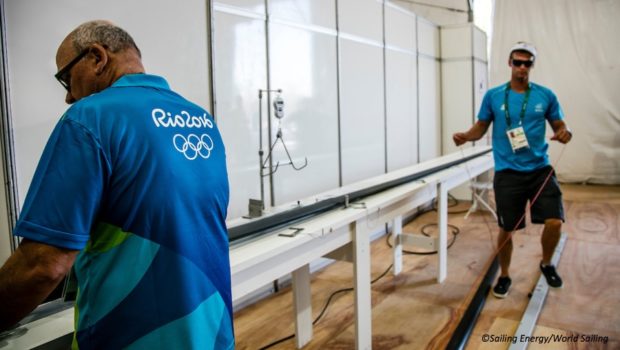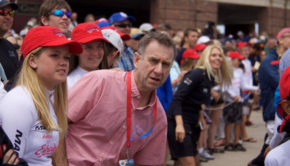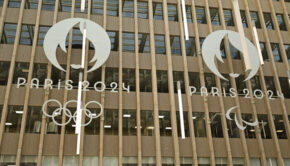Keeping it Fair at the Rio Olympics
Published on August 7th, 2016
By Craig Leweck, World Sailing
The essence of one design competition is the rules by which each class uses to control the playing field. As is common at championship events, the measurement stage prior to racing offers that opportunity to ensure each boat is compliant. And at the Olympic Games, this stage is more thorough than ever before.
“A typical world championship will check most of the critical items but the sheer number of competitors does present limitations,” notes Jason Smithwick, Director of Technical and Offshore for World Sailing. “At the Olympic Games, we have the opportunity to be more thorough to insure the playing field is as level as possible.”
For six days before competition begins Dimitris Dimou, the Equipment Committee Chairman, is leading a team of hard working officials processing the boats and gear for the 274 entrants competing amid the ten events at the Games. The provided equipment – the Laser and RS:X – can breeze through in 15 minutes. At the other end of the scale are the 470 and Finn which have multiple manufacturers and can take up to an hour.
The Rio Test Events in 2014 and 2015 provided the competitors with a glimpse of the process. “Generally, the sailors have been really prepared, as one might expect at this level. There are 56 countries competing, and even though some don’t have a long history of competing at this level, the process so far has gone fairly well.”
Beyond the equipment limitations, the measurement stage ensures that there is not branding or boat names that are not compliant with IOC regulations. “We had named our boat Gisele after the Brazilian model but had to cover it up,” remarked Croatian 470 helm Sime Fantela. The measurement stage also allows for the broadcast equipment for cameras and trackers to be affixed.
With regard to spare equipment, each event is guided by the class rules. “For the Finn class, they can measure in two masts and two sails, so the sailors have options in the case of damage or different wind strengths,” explains Smithwick. “For the boats with spinnakers, the nation flag is prominent on the sail, so those classes all measure in a second spinnaker with the flag so it’s ready. We carry those on the water, so if they do rip their spinnaker during a race, the replacement is readily available. For the provided equipment such as the RS:X and Laser, we have those spares to insert if needed.”
If equipment is damaged in competition for which a competitor uses an unmeasured replacement, the competition regulations provide guidance. “For example, if a 470 team broke their spinnaker pole, but have an uncertified replacement available, they can use it but we will measure it post-race,” notes Smithwick. “However, we may still decide they have to repair their original pole. For a larger item, such as a hull, we have already been asked if a competitor can have a replacement ready. We are determining that protocol.”
As for maintaining standards during competition, the measurement station remains in place throughout the Games. “We have people on the water that will do random equipment checks during racing,” said Smithwick. “The measured equipment has certification decals, so we can check for that and insure all safety equipment is in place along with other particular items required by each class. We also have a team that can walk the boat park to check for compliance. For the top ten that qualify for the Medal Race, there is a secondary measurement process the night before the race after which the boats are kept within a quarantined area. It is all about insuring fairness amongst the competitors.”
How to follow the Olympics… click here.









 We’ll keep your information safe.
We’ll keep your information safe.